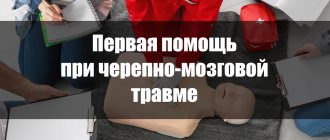These figures could be less frightening if the victims had time to receive professional, timely assistance.
To attract public attention to the problem, Red Cross and Red Crescent activists initiated the celebration of World First Aid Day. Traditionally, this holiday is celebrated on the second Saturday of September; this year it falls on the 12th. To support this event, we will talk about how to help someone who is fainting.
First aid for fainting
It is necessary to make sure that the person is breathing. You need to tilt the person’s head back and pay attention to whether the chest is moving, feel the pulse on the carotid artery, and place your palms on your mouth. In order to improve blood circulation, you need to elevate the patient's legs. It is advisable to turn your head to the side so that in case of vomiting, aspiration does not occur. If a person is unconscious, bring ammonia under his nose.
Important: do not use the entire bottle, it is better to apply a few drops on a cotton swab. Otherwise, you can get burned, and in children you can even stop breathing. If ammonia is not available, you need to press on the painful point between the nose and upper lip.
There is no need to panic and do not overdo it in providing assistance.
Shegarsky district 1936 - 2021
First aid is a temporary measure performed to save a life, prevent additional injury, and relieve suffering until qualified medical attention can be provided by specialists.
General rules
- Call “Ambulance” 03 or 103 (from your mobile phone).
- Make sure that neither the victim nor you are in danger.
- If possible, leave the victim lying where he is until he can be assessed. If you have to move it, do so with extreme caution.
- If the victim is vomiting, place him on his side to prevent suffocation.
- If the victim is not breathing, give him artificial respiration.
- Cover the victim to keep him warm and protect him from rain and snow.
- Bandage and secure the injured organ.
- Choose the most suitable transportation method.
Loss of consciousness
- Make sure the victim is unconscious.
- If he is unconscious, check to see if he is breathing.
- If he is not breathing, clear his nasopharynx. Pull his lower jaw forward. Tilt his head back so that his chin is higher than his nose. Pull his tongue forward so that it does not cover the nasopharynx.
- If the victim does not begin to breathe, use artificial respiration.
Stop bleeding
- Lay the victim so that the wound is above the level of the heart; if the wound is on the head or neck, raise the head and shoulders.
- Almost any bleeding can be stopped by applying several layers of clean cloth. Apply a bandage to the wound and tighten it tightly.
- If the bleeding continues, you need to press the artery to the bone above the wound: on the arm - in the middle between the elbow and armpit, on the leg - in the fold between the torso and thigh.
Stopping arterial bleeding (the most dangerous) by applying a tourniquet:
- make a tourniquet from a piece of fabric at least 5 cm wide (do not use rope, nylon, women's stockings, wire);
- place the tourniquet on the damaged part of the limb directly above the wound so that it does not slip when tightened;
- wrap the fabric twice around the surface and place one end of the fabric over the other, and then pass one under the other;
- take a short strong stick, place it across the half-knot on the fabric and tie both ends over the stick into a knot;
- turn the stick so that the tourniquet is tightened. Turn it until the bleeding stops;
- tie a piece of fabric around the stick and secure it around the limb so that the tourniquet is well secured.
A note is placed under the tourniquet indicating the date, hour and minutes of its application. The tourniquet can be used for 1.5-2 hours. Otherwise, the limb will die. During this time, the victim must be taken to a medical facility.
Penetrating chest injury
- If a bullet or sharp object has pierced the chest, a whistling sound is heard as it enters and exits, so that the lungs do not collapse, the hole must be closed. This can be done by hand, a plastic bag, adhesive tape or a clean cloth folded in several layers.
- Regardless of whether the victim is conscious or not, he is placed on his side with the injured side down.
Abdominal wounds
- Cover the wound with a clean cloth bandage. If intestines or other internal organs have fallen out, do not try to put them back in place.
- Place the victim in the most comfortable position. Place a folded blanket under your bent knees, this will reduce the pressure on the abdominal wall.
- Do not give the victim anything to drink, even if he asks for water. You should also not eat or smoke.
Electric shock
- Turn off the electrical current (handle electricity only with dry hands; never use electrical appliances on a wet floor, bench or table).
- If it is impossible to turn off the current, remove the contact wire from the victim with a safe object (it should be made of a material that does not conduct or poorly conducts electric current). A stick, folded newspaper, rubber-soled shoes, sneakers, clothes - all these items can be used if they are dry.
- Never touch the victim until you have turned off the power or removed the wire.
- See if the victim is breathing. Make sure your airway is clear. Use artificial respiration if necessary.
- If the victim is unconscious but breathing, place him in a safe position.
Burns
- Burns should only be irrigated with cold, clean water. Let it run for about ten minutes until the pain subsides.
- Never open a blister that has formed over a burned area of skin.
- Never remove pieces of clothing that are stuck to a burn.
- Apply a sterile bandage to the affected area of the body.
- Apply boric acid solution to burnt eyes (half a teaspoon of boric acid per 1 glass of water).
- Wrap the victim in a clean sheet, wrap him warmly, give him 2 analgin tablets to drink (if there is information about the absence of allergies), create peace.
- If the burn, covered with blisters, occupies an area larger than the palm of your hand, take the victim to a medical center or call an ambulance.
- Give the victim plenty of fluids: tea with sugar, fruit juice, water with salt diluted in it (2 teaspoons per 1 liter).
Frostbite
- The victim is brought into a warm room, the affected areas are wiped with alcohol (vodka) and rubbed with clean hands until the skin turns red.
- If a significantly larger area of the extremities is frostbitten, make a warm bath from a weak (pale pink) solution of potassium permanganate at a temperature of 32-36 ° C or apply heated objects.
- In case of general frostbite, the victim is warmed up as quickly as possible (brought into a room with a temperature of 20-22 ° C) and given hot tea, coffee, vodka.
Food poisoning
- Gastric lavage at home: the victim is given a large amount of water to drink (1-2 liters) and artificial vomiting is induced - placing fingers deep in the mouth, pressing on the root of the tongue. Then the procedure is repeated. In total, 10-12 liters of water are required to lavage the stomach.
- The last portions of rinsing water should be clear and free of food residues.
Fainting
- The victim is placed on a couch (head below feet) and given ammonia to sniff.
Sun and heat stroke
- The victim is placed in the shade and cooled - cold is applied to the head and heart area, and the skin is wiped with a wet towel.
- If you complain of pain in the heart, give validol or nitroglycerin under the tongue.
Help for carbon monoxide poisoning
Carbon monoxide (carbon monoxide - CO) is a product of incomplete combustion of organic substances. A highly toxic gas, colorless, sometimes with a burning odor. Leads the body to acute oxygen starvation.
Poisoning can occur in a fire, during the operation of gasoline engines, combustion of natural gas, etc. Death usually occurs as a result of CO poisoning in enclosed spaces with poor ventilation.
Poisoning, depending on the concentration of CO in the air, the duration of its exposure and the person’s condition, can be gradual or instantaneous.
Sudden loss of consciousness is possible, incl. and driving.
Signs of poisoning
- with a mild degree: the appearance of a feeling of heaviness and pulsation in the head;
- pain in the temporal region and forehead (“compression with a hoop”);
- darkening and flickering of “spots” in the eyes, tinnitus;
- dizziness, shallow breathing, increased heart rate, dilated pupils, increasing muscle weakness;
In the absence of help, shallow breathing, cardiac arrhythmia, dull heartbeat, convulsions and death of the victim are possible due to acute oxygen starvation.
First aid
- Take to fresh air and lay on your back.
- Unbutton your clothes and open your chest.
- Cool your face and chest with cold water, snow, ice.
- Wrap a rag soaked in cold water around your head.
If the victim does not come to his senses:
- make him sneeze, causing irritation in his nose;
- rub the victim’s chest with a mitten, scarf, or other object until breathing appears;
- perform artificial respiration;
- deliver the victim to a medical facility or call a doctor.
What should you do after fainting?
If fainting lasts less than 5 minutes and does not have additional symptoms, then there is no need to worry. You just need to rest for your body to recover.
what to do after fainting
But there are indications that require immediate consultation with a doctor:
- If you hit your head when you fall.
- 2 or more fainting episodes per month.
- A pregnant woman or a person with any cardiovascular diagnosis lost consciousness.
Only a doctor will be able to determine whether there is cause for concern and, if necessary, prescribe additional examination.
Diagnostic features
A patient with frequent occurrences of syncope is examined in the hospital using an ECG to refute or verify that such a condition is cardiac in nature. During the diagnosis, the following conditions are noted:
- If a patient is under forty years of age and has no abnormalities in the cardiac structure on the cardiogram, then syncope is most likely caused by the presence of neurological disorders.
- If a patient over forty years old has no lesions on the cardiogram, then the examination still begins with a detailed study of the condition of the heart.
In addition, you need to know the following:
- syncope caused by physical overexertion is not safe for people of any age group;
- the older the patient who experiences syncope, the greater the likelihood of having serious cardiac problems that caused this type of condition;
- if the duration of cardiac interruptions to the point of fainting is more than 5 seconds, then such interruptions are signs of serious heart disease;
- uncontrolled muscle twitching is quite often caused by temporary cerebral ischemia caused by the presence of heart disease;
- Even short syncope if a person has heart disease is usually considered a serious symptom.
It is especially dangerous if syncope is accompanied by the following factors:
- painful sensations behind the chest;
- in 60 seconds more than 160 heart contractions;
- heavy sweating;
- slow heartbeat;
- low pressure.
Why might fainting happen?
The cause of fainting is a lack of oxygen for optimal functioning of the brain. Reasons for this condition:
- Sudden change in body position. If you sit or lie down for a long time and then quickly get up, your heart may simply not have time to pump blood to your head.
- Blood loss. Due to injury, hemorrhage, internal bleeding.
- Dehydration.
- Intoxication. Moreover, they have completely different etiologies: alcoholic, infectious, food.
- Endocrine dysfunction: thyroid pathology, diabetes mellitus.
- Starvation. Due to lack of nutrients, the production of red blood cells and hemoglobin in it is reduced. As a result, a drop in blood pressure.
- Decreased oxygen supply to the brain.
- Diseases of the cardiovascular system.
Often completely harmless situations lead to fainting, but sometimes there are serious health problems.










